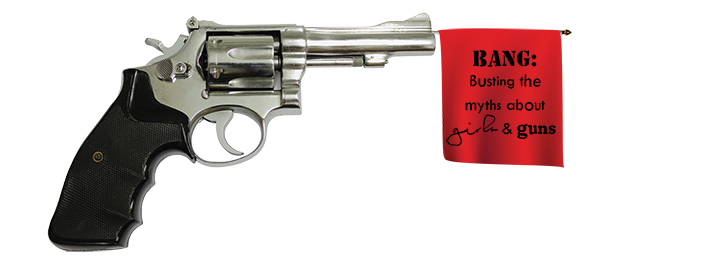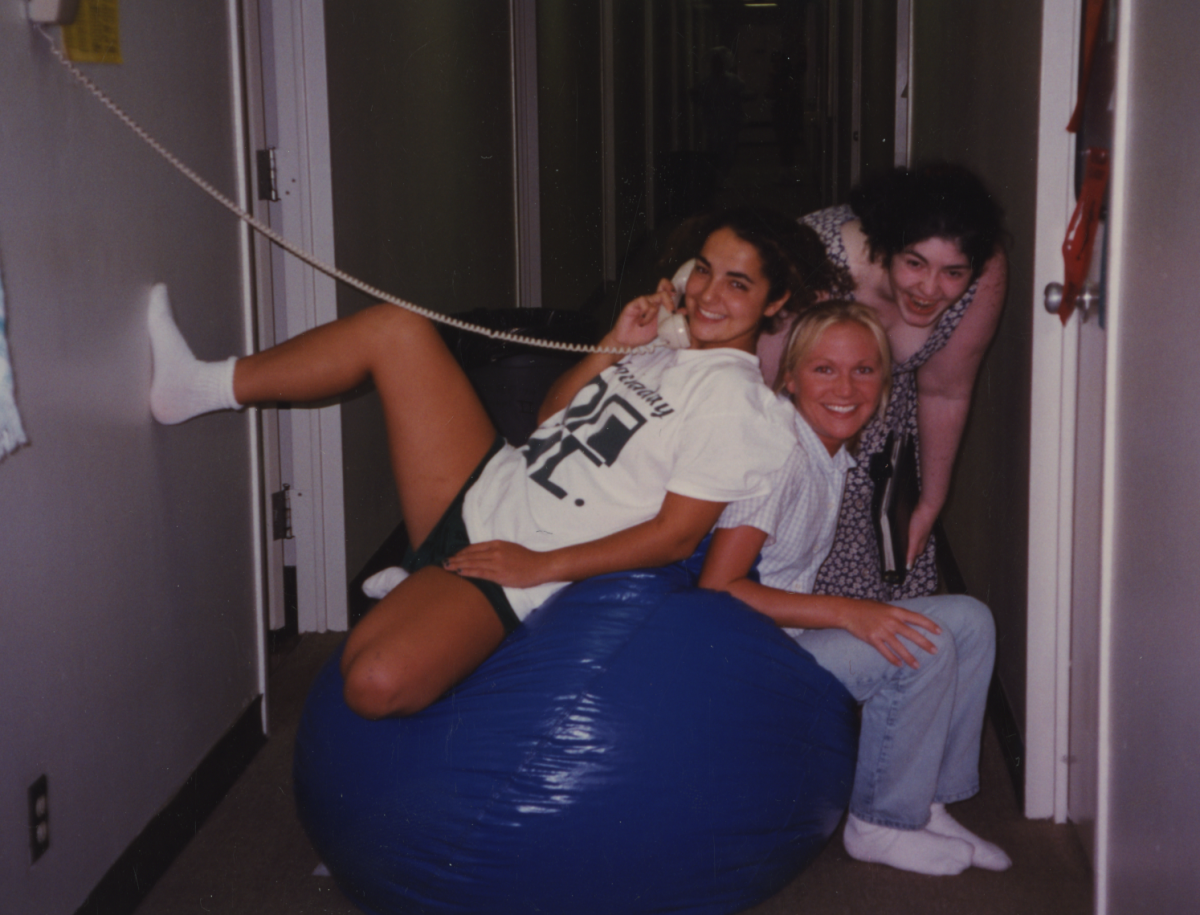Bang: Busting the Myths about Girls and Guns
Classically, women are not supposed to want guns or not supposed to like guns or not supposed to use them or own them, but they do.
CAITLIN KELLY
AUTHOR OF BLOWN AWAY: AMERICAN WOMEN AND GUNS

Though guns seem ubiquitous in the modern world, traditional perceptions align men with guns, not women. An October 2011 Gallup poll, however, reported that female gun ownership is at a record high of 43 percent. For a number of reasons, women are taking advantage of the right granted to them by the Second Amendment.
“It’s a feminist issue. It’s a question of power. It’s a question of autonomy. It’s a question of what women want to do,” Kelly said. “Women own guns for all the reasons that men own guns.”
The only area in which women fall short? Mass shootings.
The 2007 Virginia Tech shooting. Seung-Hi Cho. Male, 23.
The 2009 Fort Hood shooting. Nidal Malik Hasan. Male, 39.
The 2012 Aurora shooting. James Holmes. Male, 25.
The 2012 Newtown shooting. Adam Lanza. Male, 20.
“There’s a million ways that women may want to use or own a gun,” Kelly said. The following are just a few.
Guns for Fun: Hunting and Shooting
Deep in the heart of a Southern population in which 54 percent of people own guns, according to the October 2011 Gallup poll, it is not surprising that many Hockaday students and faculty hunt and shoot for recreation. What may be surprising, however, is their level of responsibility and commitment to safety precautions.
Junior Sarah Startz grew up around guns because her dad, from a rural area in South Texas, grew up around guns. Though deer and dove hunting was a veritable family tradition, Startz said she never hunted until she was older.
“When I was younger, we always had guns in the house, but I was never allowed to play with guns,” she said. “I didn’t get water guns when I was little. I didn’t play video games with guns in them. I have many memories of getting cowgirl kits, and my parents taking the guns out and not letting me play with them.”
She said her parents wanted to establish that a gun was a serious weapon, not a toy. They inculcated her with the principles of gun safety and of doing things by the book, she said.
“My dad’s really big on if you kill it, you clean it,” Startz said. “I think most Texans, because it’s so ingrained in our culture, are responsible hunters. There’s a big push for responsible hunting and a big push for responsible gun use. Texans take pride in that.”
Hunting, which Startz called a “useful sport,” also protects the environment from overpopulation of certain species, including deer. Hunters can responsibly take care of the deer, use their meat and control their population size to prevent a whole population from dying of starvation, she said.
Some women, however, shy away from killing animals and the responsibilities that hunting implies, and instead prefer target shooting for sport.
Upper School self-defense teacher Meg Hinkley said that she grew up shooting skeet and trap and begged her dad to take her hunting when she was 14, just like her four brothers.
“I got my shot all lined up, and then I started crying,” Hinkley said. “I couldn’t shoot the deer.”
Upper School history teacher and former C.I.A .and F.B.I. agent Tracy Walder, who grew up in the Newport Beach area of Southern California, had no exposure to guns and hunting as a child and teenager.
“It just wasn’t the culture,” Walder said. “Everyone was a surfer. We didn’t have guns.”
Though she said she does not understand hunting, she does not mind that others hunt, citing that some of her best friends hunt for sport.
Walder, however, said she enjoys target shooting, but she noted the pervasive sexism at the shooting range. When Walder lived in California while working for the FBI, she went to a gun range with her father to practice for an upcoming qualification.
“We walked in, and I think it’s fair to say that I didn’t even exist to the people in there, and I was the one who was the law enforcement official, and I was the one who had the weapon, and I was the one who was paying for the range,” she said.
They instead deferred to Walder’s father, assuming that, as a man, he would be the higher authority at the gun range.
In modern day, such sexism is unwarranted. The facts speak for themselves.
“Statistically, women are better shots than men,” Kelly said.
The 2012 London Olympics showed just that. With her gold medal win this summer, shooter Kim Rhode became the first American ever to win an individual medal in five straight Olympics.
Senior Ashley Rich grew up shooting targets and skeet with many male family members.
“Being out there with the boys and being able to shoot as well as them is just a pride and a strength thing,” she said.
The tide has turned. January 2012 marked the first annual National Take Your Daughter to the Range Day. In 2011, according to the National Sporting Goods Association, 7.5 million women participated in target shooting and hunting with firearms. The range was long overdue for a makeover in pink camouflage.
Video Games
Women are not only showing their gun-shooting prowess in the real world but also in the virtual world of video games.
A 2012 Entertainment Software Association survey found that 47 percent of gamers are female. Additionally, women 18 or older represent a third of the gaming population, making them eligible to play games with an M for mature (17+) rating, which can include guns and gun violence.
The games have a very high-fidelity look and feel said Dr. Monica Evans, Assistant Professor of Computer Game Design at the University of Texas at Dallas.
Following the Newtown shooting and because of the hyper-realism in violent video games, Vice President Joe Biden met with representatives from ESA on Jan. 11, 2013 to discuss regulations such as warning labels, which are beyond the current Entertainment Software Rating Board ratings.
Seventeen-year old Startz said that it will suffice to follow the ESRB ratings. Although Startz was not allowed to play violent video games when she was younger, she now plays these “strategy-type” games.
“Most of the games that involve shooting people and killing people are rated M for mature,” Startz said. “I think if you listen to the age rating it’s okay.”
In 2011, the National Purchase Diary (NPD) Group/Retail Tracking Service cited action games and shooting games as two of the most popular genres, respectively representing approximately 18 and 19 percent of games sold. The same group ranked Call of Duty: Modern Warfare 3, which has an M rating, as the top selling video game of 2011.
Junior Anna Herbelin, also 17 years old, said she plays Call of Duty, among others of this game genre.
“Having an older brother, it’s inescapable,” Herbelin said.
Like Startz, however, Herbelin said she thinks the video game rating system is a good idea.
“Playing Call of Duty every once in a while is totally fun, but when you’re a 9-year-old kid, maybe you don’t need that yet,” Herbelin said.
Studies, however, show the contrary. Findings from the Journal of Pediatrics 2009 review of media violence “do not support the conclusion that media violence leads to aggressive behavior.”
President Barack Obama nevertheless proposed further research on the effect of violent video games on young people because many people still ask the same question Kelly does: “What is the actual productive point of playing a game where you learn how to blow people to smithereens?”
Evans said that there is a lack of long term studies on the effects of video games simply because video games have only been in existence for about 50 years. The first video game is generally dated in 1962 with the Seven Versions of Space War. She said current video games differ drastically from the originals and even those made in the ‘80s, ‘90s, and early 2000s.
“There’s really a lot that we don’t know,” Evans said.
Without looking at video games as a whole, Evans said she thinks the video game industry makes an easy target because of what she calls the “problem of content.” This refers to the disconnect between what appears to be happening on the screen and what is actually happening. Violent actions in video games do not necessarily correspond to violent intentions.
“What the person playing the game sees is this,” Evans said. “There is a glitch in the game that allows me to exploit a loophole so that I can get a resource for free.”
While Evans said that all games are educational by definition, they are also an art form meant to provide entertainment.
“It’s the thrill of the chase kind of idea,” Herbelin said. “You don’t see the people in the game as people; you see them as targets, so it’s essentially like target shooting on a mass scale with things with faces but in CGI.”
Though Herbelin said this virtual target shooting is much easier than the real deal, with less reloading time and less danger, like any proud Texan, she still enjoys shooting at the gun range.
“There’s a much bigger bang,” she said. “So there’s kind of the excitement of that, the adrenaline rush.”
Self-Defense
For women, however, guns are not all fun and games. A very compelling argument for women owning guns, Kelly said, is that they are very likely to become crime victims. According to the Centers for Disease Control and Prevention, nearly one in five women will be raped during her lifetime.
Hockaday requires students to take a self-defense class during their senior year. In her classes, self-defense teacher Meg Hinkley puts the girls through simulation attacks involving a fake gun. While she notes that guns are only used in seven percent of sexual assaults, she said the girls need to know how to react in these situations.
If the girls remain calm and use simple self-defense tactics—giving up their stuff, making lots of noise and running away—less than four percent of these attacks will result in an actual shooting, Hinkley said.
Though Hinkley said that guns can be a good method of self-protection, she thinks that physical defense skills preclude the need for a gun. In attack situations, she said she would use many other physical defense maneuvers before using a gun.
“What bothers me more is [women] will say I’ve got a gun and that’s my self-defense,” she said. “But they don’t necessarily train on a regular basis and they haven’t necessarily learned all of the other information about their personal safety.”
After taking self-defense, Rich said that having a gun seemed less necessary, though she considers owning one in the future if she lives alone.
The appeal of gun ownership depends on your lifestyle and where you live, Hinkley said. In her research, Kelly said nurses made up an occupational group that was likely to own guns. Carrying syringes in their cars or driving alone in the dark through bad neighborhoods to work the night shift makes them susceptible especially to drug-related crime.
Spokesman for the Bureau of Alcohol, Tobacco and Firearms Andrew Young said one of the most common gun regulation violations in North Texas is the use of a firearm in a drug or other violent crime.
Hinkley is taking a concealed handgun license course because it is an additional skill that she wants in order to expand her knowledge and make her a better teacher, she said.
Startz and Herbelin both said they believe in the merits of gun education, but Hockaday students may have a problem when the time comes to shoot.
“The higher your IQ, the longer you will hesitate to shoot,” Hinkley said. “Think about the finality.”
Kelly took a three-day gun class while researching for her book.
“A lot of it is like any sport. It’s muscle memory. It’s being trained so consistently and so intensely that in that moment you know exactly what to do and how quickly to do it and accurately,” Kelly said.
It really boils down to the person and the situation, Walder said. Whereas Walder has had eight months of training in high-stress environments and is equipped to handle those situations, not everyone is.
“Some people completely shut down. Some people get very confused. Some people become overly emotional. Some people become incredibly passive. Some people become overly aggressive that they almost kind of self-destruct in a way,” Walder said.
She said very few people become logical and methodical and that you cannot judge what your brain response will be in a very traumatic situation.
“There’s kind of almost a knee-jerk reaction. [Women] hear about a crime or they hear about someone breaking into someone’s home, and they say I’m getting a gun,” Hinkley said. “They think that’s going to solve it all. It’s just one option and you have to understand its benefits and its limitations and see a bigger picture.”
Give it a Shot
Girls have guns. They have stake in the gun control discussion; they have informed, logical opinions about the issue.
Fifty-nine percent of Hockaday Upper School girls surveyed said the government should be more restrictive in the qualifications for having a gun permit while only 17 percent agreed that gun ownership should be severely restricted or banned.
With such a high number of guns already in circulation, however, Walder said that most of the gun-regulating rhetoric is simply not feasible.
“After a while, you’ve just got a BB gun that you can only fire at a range, and that’s not really useful to anyone,” Herbelin said. “You start getting into all these technicalities and at the end of the day you end up with an across the table gun ban, and that’s just not going to work out.”
Though well intentioned by the Founding Fathers as a means of protection from the government, the Second Amendment opened a Pandora’s Box of subsequent gun law and regulation. But as Walder said, the focus should not be on regulation but rather on responsibility.
While the topic is hot, the time is now for girls to make their voices heard in the gun debate.
-Mary Clare













